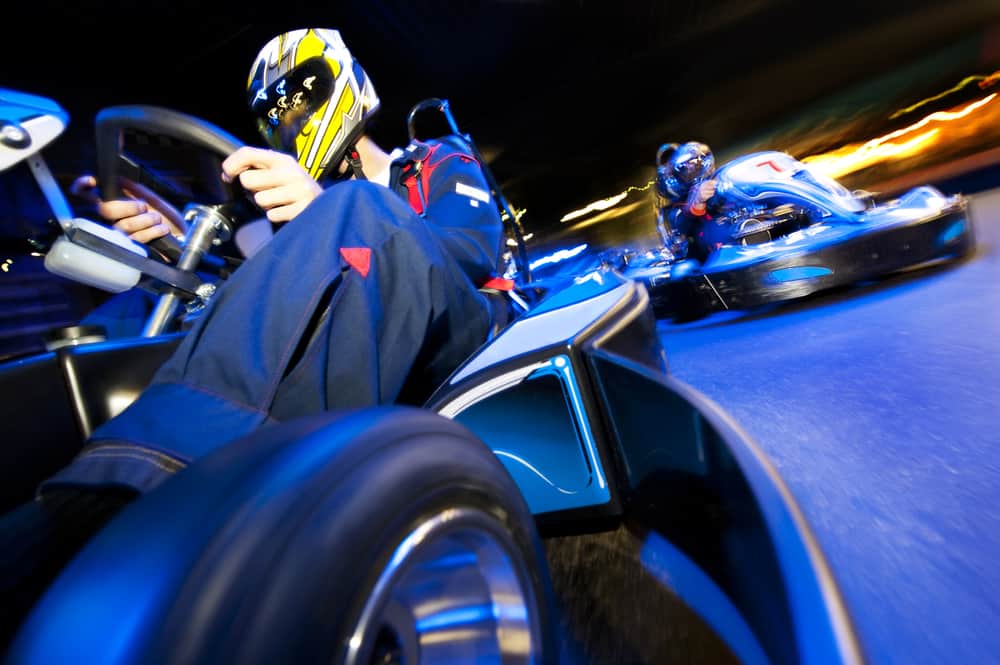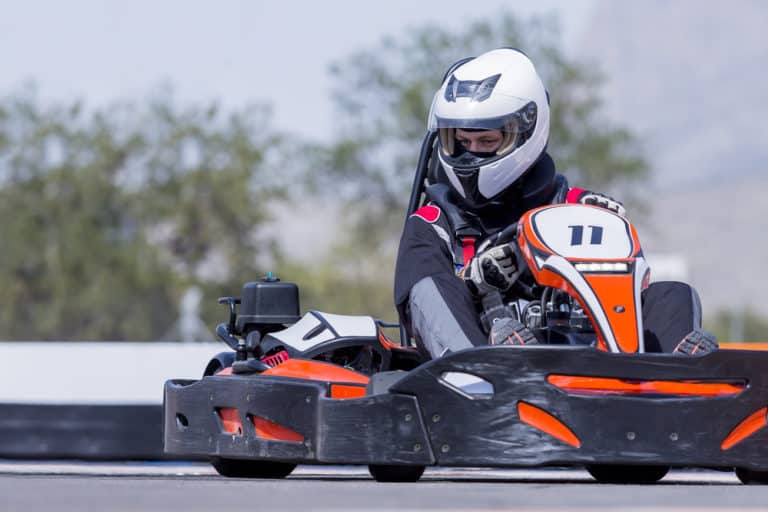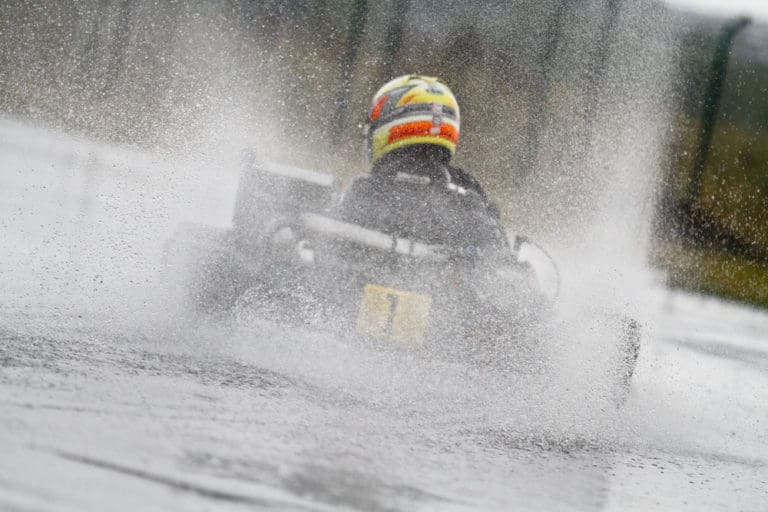Image: Shutterstock.com
Go-karts are wonderful things. There are few other machines that offer the same level of motorsport fun while being accessible to almost everyone. Go-karts are fantastic training vehicles for prospective young drivers, and they tend to breed the world’s best racing drivers. There are many different types of go-karts around these days, but they all seem to have the same basic construction. This leads many drivers wondering, “are all go-karts rear-wheel drive?”
Almost go-karts are rear-wheel drive. Only in recent years have front-wheel drive and all-wheel drive go-karts been developed. Most go-karts are rear-wheel drive because it makes the machine more simple. Other drive systems are much more complicated and much more expensive to build.
While most go-karts are rear-wheel drive, and they are for good reasons, there are a handful of modern go-karts that are built with front-wheel drive or all-wheel drive systems. Rear-wheel drive is still the norm and is the most efficient, most reliable, and most simple drive system for any go-kart. Let’s examine whether or not all go-karts are rear-wheel drive, why most go-karts are rear-wheel drive, and what other do-kart drive systems are like.
Are All Go Karts Rear Wheel Drive?
Go-karts are simple machines, but they are still built for racing. They need to be built with the same parameters in mind as racing cars and therefore are built within certain constraints that are optimized for racing vehicles.
These racing vehicles have to be light-weight, simple, cheap to run, tough, easy to drive and control well, as well as being optimized for use on a race track.
This means that go-karts are surprisingly complicated to build, more complicated than many people realize, and there are many factors that decide how they are built and why they are built the way that they are.
Due to the fact that most go-karts are built to be racing vehicles, most of them are built with rear-wheel drive systems rather than front-wheel or all-wheel drive systems.
Almost all go-karts are built with rear-wheel drive, for the purposes are racing and simplicity.
However, in recent years there have been go-karts developed with front-wheel drive and all-wheel drive systems. These go-karts are built for specific purposes or as engineering experiments and not the norm in the world of go-karts.
Not all go-karts are rear-wheel drive, but almost all of them are, as there are very few front-wheel drive go-karts and even fewer all-wheel drive go-karts.
The go-karts that are used for track racing are usually rear-wheel drive, which is why most karts use this drive system, but in very recent years, there have been some racing go-karts with front-wheel drive systems that have been developed for training young drivers to race in front-wheel drive cars.
For the most part, go-karts are rear-wheel drive, but there are some exceptions that have been built for specific purposes.
Why Are Most Go Karts Rear Wheel Drive?
While there are a handful of go-karts that are not rear-wheel drive, most of them are, and they are built this way for good reason.
The size of a go-kart makes it extremely difficult to build it with a front-wheel drive system.
Most go-karts are built with rear engines, for weight distribution, the seating arrangement of go-karts, and for drive transfer.
A vehicle that has an engine mounted at the back is able to transfer power to the rear wheels very easily, both due to the proximity of the engine to the rear wheels and the simplicity of mounting the drive mechanism from a rear engine to the rear wheels.
An engine mounted at the rear over a rear-wheel drive offers many benefits. The heavy engine presses down on the drive wheels, which provides the wheels with more traction. There is no need for complicated drive transfer mechanisms or linkages to transfer the engine’s power to the front wheel or all of the wheels.
Mounting the engine at the back means that there is space for the driver to sit in the middle of the kart. The seat can also be mounted lower down within the go-kart due to the lack of complicated linkage systems that would need to run around or under the driver’s seat.
For a go-kart to have front-wheel drive, either the engine must be mounted at the front of the kart, or the kart must be built with a complicated linkage system to transfer the power from the engine at the back to the front wheels.
The same problem is true for all-wheel drive. The linkage systems to transfer the power from the engine to all four wheels of the kart is simply too complicated to be a viable option for every go-kart, especially go-karts that are built to be fast and light-weight.
For these reasons, most go-karts, especially racing go-karts, are built with rear-wheel drive systems.

What Are Other Go Kart Types Like?
While rear-wheel drive is the standard and the norm in the world of go-karts, it is true that there are some go-karts that are built with front-wheel or all-wheel drive systems.
These karts are usually very specialized and built for specific purposes or built as an engineering showcase rather than a serious go-kart.
However, it is a good thing to know that these karts exist, as there may be future go-karts that are built in these ways for purposes other than racing.
Let’s take a look at what front-wheel and all-wheel drive go-karts are like:
Front Wheel Drive
Front-wheel drive go-karts must be built in very specific ways for them to function well.
The very first front-wheel drive go-kart that was built was very unique in its construction. This kart had two engines, one mounted above each front wheel. This allowed each engine to drive one of the front wheels, which eliminated the need for complicated linkage systems to drive the wheels.
This clever solution was not very practical, and the kart was dangerous and difficult to control.
Modern front-wheel drive go-karts are front-engined vehicles, and they are primarily used to teach young racing drivers how to handle front-wheel drive cars that are built for racing.
They are specifically used to train touring car racers, as many modern touring cars are front-wheel drive cars, which handle very differently to rear-wheel drive vehicles.
Front-wheel drive go-karts are very prone to under-steer and tend to be slower than rear-wheel drive go-karts due to their extra weight and poor cornering ability.
All Wheel Drive
All-wheel drive go-karts are very rare, but there are some specialist kart builders who produce them.
These karts are not usually built for racing, as they are very heavy due to the extra weight added by the mechanical linkages and transfer boxes required to send power to the wheels from the engine.
Many all-wheel drive go-karts are built with two engines, which proves the power that is required to drive all four of the wheels effectively.
These karts are heavy and slow, which does not make them suitable for racing, but they are useful for other applications.
Conclusion
Most go-karts are rear-wheel drive, but not all. The norm in the world of go-karts, especially racing go-karts, is rear-wheel drive.
Rear-wheel drive is ideal for go-karts, as it proved the most simple construction for these vehicles, the lowest center of gravity, the best weight distribution, the most effective power transfer, and provides the best handling for these light-weight vehicles.
Front-wheel drive go-karts are possible, and they have been built, but they are not as good as rear-wheel drive go-karts.
If a go-kart is built with front-wheel drive, it means there must be very complicated power transfer mechanisms built into the kart or the engine must be moved to the front of the kart.
This is not ideal in these small, light-weight cars, as it drastically changes and impairs the handling of the kart, which makes them much more difficult to drive well, and makes them slower around a track.
All-wheel drive go-karts are around as well, but they are not built for racing. They are very heavy and often have two engines, which makes them bad racers but good utility karts.
While rear-wheel drive is not the only option for modern go-karts, it is definitely the best option. All racing go-karts are rear-wheel drive, and they are built in this way for good reason!
The next time you are at the go-kart track, ask the drivers and mechanics why their karts are rear-wheel drive, and they will explain how it is the best configuration for racing go-karts!
References
https://50to70.com/2016/01/19/front-wheel-drive-kart/
https://www.cyclekartclub.com/forum/custom-karts-forum.6/front-wheel-drive-for-the-sake-of.9941/
https://news.speedsociety.com/this-front-wheel-drive-go-kart-is-something-we-have-never-seen/






